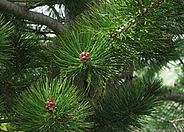The alpine tree line marks a distinct change in mountain landscapes as an ecological boundary for tree growth. Here, Swiss stone pine (Pinus cembra) represents the enigmatic tree species that predominantly grows in the continental parts of the central European Alps, but also occurs in disjunct stands along the Alpine periphery and in the Carpathians.
Contents ¶



Swiss stone pine is characterized by life history traits that make it a suitable model system for ecological and evolutionary research. The long-lived trees disperse their pollen through wind, as is typical of conifers. In turn, seed dispersal relies on the food storage behavior of a territorial bird, the European nutcracker (Nucifraga caryocatactes). Each bird establishes thousands of caches containing a few of the wingless seed, which are rich in fat and proteins, as food reserves for winter. Unrecovered seeds may germinate in favorable sites and, if seedlings establish successfully, the bird's food storage activity contributes to effective dispersal of P. cembra.
To unravel processes such as dispersal and adaptation to local environmental conditions, molecular markers are useful tools. In various projects, we have combined genetic and ecological approaches to better understand the evolutionary biology of P. cembra and to contribute to its sustainable use and conservation where necessary. Considering spatial scales from the stand level to the entire natural range, we describe the genetic structure of P. cembra to infer small-scale dispersal, patterns of relatedness and potential inbreeding, but also its postglacial history that has left imprints on the genetic structure in extant populations.
